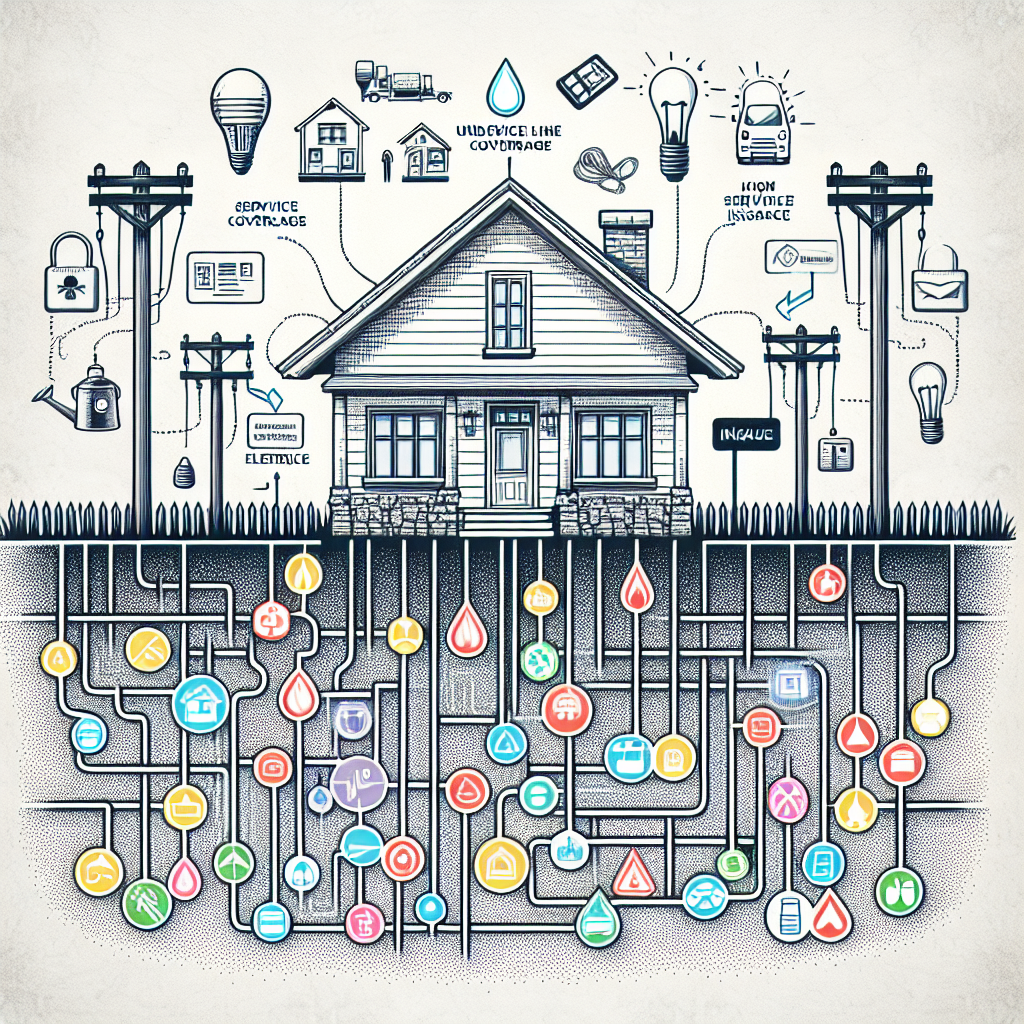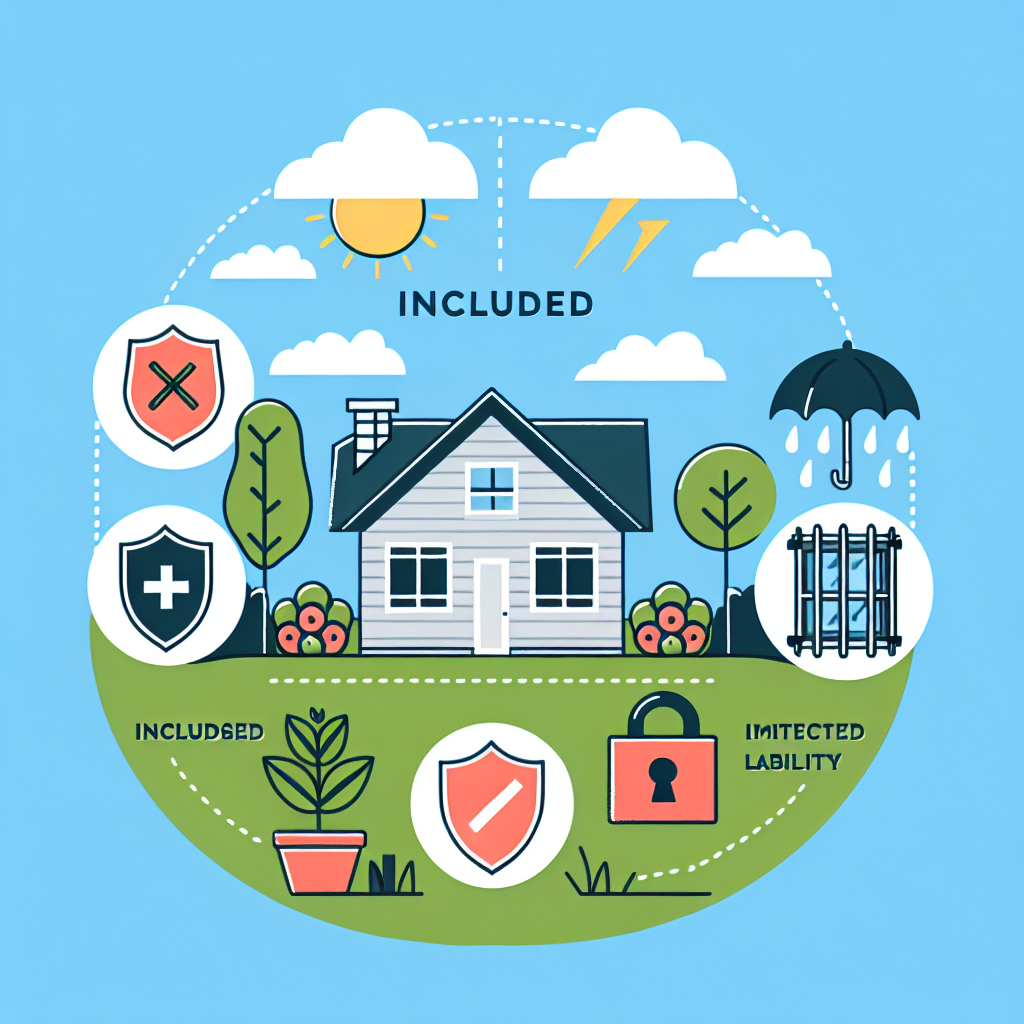Filed under Home Insurance on
Service Line Coverage on Home Insurance Explained

You never think about the pipes and cables buried beneath your yard—until a gurgling drain, a sudden power loss, or a muddy sinkhole says otherwise. When an underground pipe collapses or a line cracks from freeze-thaw cycles or invasive tree roots, the repair bill is yours, not the city’s. That surprise is what catches many homeowners off guard. The right protection can bridge the gap between a household budget and a costly excavation job.
That’s where Service Line Coverage on Home Insurance enters the conversation. It’s a relatively small endorsement that can prevent an outsized expense, and it’s growing in popularity as aging infrastructure and extreme weather strain underground systems.
What Service Line Coverage Actually Is
At its core, this coverage is an endorsement you add to your homeowners policy to cover damage to underground utility lines that you own and are responsible for. It typically applies to the service lines that run from the street or utility connection to your home and sit on your property—think water, sewer, electrical, natural gas, and data/communications lines.
Without this endorsement, the standard homeowners policy (HO-3 or HO-5) usually excludes wear and tear, deterioration, and most utility line issues below ground. Insurers design Service Line Coverage on Home Insurance to fill that gap by responding to a range of causes, including root intrusion, corrosion, mechanical breakdown, collapse, freezing, and even certain types of accidental damage during excavation.
In plain terms, it can pay for the expensive parts of a repair that most people don’t account for: finding the break, trenching to reach it, replacing sections of pipe or cable, restoring the yard and hardscaping, and sometimes even providing additional living expenses if the home is uninhabitable due to the loss of a critical utility.
Why It Matters Now
Several trends are making this endorsement more relevant:
- Aging infrastructure: The American Society of Civil Engineers regularly highlights the strain on water and wastewater systems nationwide. Many neighborhoods still rely on older clay, cast iron, or galvanized lines that are more vulnerable to damage.
- Weather volatility: Freeze-thaw cycles, drought followed by heavy rain, and ground shifting stress underground lines. Climate-related extremes are increasing, according to numerous industry briefings.
- Mature landscaping: Large, well-established trees are good for curb appeal but notorious for root intrusion into sewer laterals.
- Rising repair costs: Contractor labor, trench safety, and materials have grown costlier, and urban jobs often require permits, traffic control, or concrete/driveway work.
Insurer loss data shared in industry conferences indicates that a typical service line claim can range from roughly $3,000 to $10,000, with complex sewer replacements topping $15,000 to $20,000 when excavation is extensive. The Insurance Information Institute and several large carriers have echoed that underground utility failures are not uncommon—especially on older homes in freeze-prone or tree-lined neighborhoods.
What’s Usually Covered
Coverage varies by carrier and state, but most policies extend to buried lines you own and that serve your home, including:
- Water supply lines
- Sewer and drain laterals
- Natural gas lines
- Electrical service cables
- Internet, cable, or telephone lines
Covered causes of loss often include:
- Wear and tear, rust, and corrosion
- Tree root intrusion
- Ground settling, heaving, and collapse
- Mechanical breakdown
- Freezing (depending on region and form)
Beyond repairing or replacing the line, Service Line Coverage on Home Insurance commonly pays for ancillary costs that make these claims so expensive:
- Excavation and trenching to access the line
- Backfilling and compacting the soil
- Repairing sidewalks, driveways, and patios affected by the dig
- Landscaping restoration, within limits
- Applicable permits and inspections
- Loss of use/additional living expenses if the failure renders the home temporarily uninhabitable
Note that the exact list and definitions are found in the endorsement, and not all carriers include every item above. Always review your specific form or ask your agent to walk you through it.
What’s Usually Not Covered
Equally important is knowing the typical exclusions. These are common carve-outs in many endorsements:
- Lines owned by a utility or municipality (i.e., beyond the point of your ownership)
- Interior plumbing beyond your foundation walls
- Septic tanks, leach fields, or private treatment systems unless specifically included
- Sprinkler or irrigation systems
- Shared lines that serve multiple properties (unless your form expressly allows it)
- Pre-existing damage or known defects before the policy start date
- Routine maintenance and cleaning (e.g., clearing a clog without damage to the line)
- Flood-related damage if excluded elsewhere in the policy
Also clarify the difference between service line coverage and water backup coverage. Water backup handles damage inside the home from a backed-up drain or sump (think ruined flooring), while service line responds to the broken or collapsed line outside. Many homeowners carry both, since one does not automatically include the other.
How The Coverage Is Structured
Most insurers package this endorsement with a set limit of insurance and a flat deductible. Common parameters include:
- Limits: $10,000 to $20,000 per occurrence are typical, with optional increases up to $50,000 from some carriers
- Deductibles: Often $500, though you may see $1,000 or more
- Premium: Roughly $30 to $100 per year in many markets, influenced by home age, region, and insurer pricing
- Waiting period: A short waiting period may apply when first adding the endorsement
Because excavations can escalate quickly, consider whether your home’s setup warrants a higher limit. Long driveways, elaborate hardscaping, or a deep utility run from the street can amplify costs beyond the base $10,000 limit.
The Claim Process, Step by Step
If you suspect a service line failure—say, sewage backing up, persistent drain issues, or unexplained yard moisture—this sequence helps streamline the response:
- Prioritize safety: If you smell gas or suspect an electrical issue, evacuate and call your utility and emergency services.
- Call your insurer or agent: Ask whether the symptoms point to a potential service line claim and confirm next steps before digging.
- Use qualified contractors: Many carriers have preferred vendors experienced in trenching, camera scoping, and line replacement.
- Document everything: Photos, videos, plumber’s reports, and the camera inspection footage help prove the cause and extent of damage.
- Dial 811 before you dig: This is both a legal requirement in most areas and a critical safety step to mark underground utilities.
- Coordinate permits and restoration: Your adjuster can advise what’s covered, including hardscape and landscape restoration.
Prompt reporting and coordination with your adjuster can prevent claim hiccups and ensure the excavation work is covered before the backhoe arrives.
Who Benefits Most From This Endorsement
While nearly any detached home can benefit, certain situations increase the value of Service Line Coverage on Home Insurance:
- Older homes (pre-1980s): More likely to have clay, cast iron, or orangeburg pipe vulnerable to collapse and corrosion.
- Large, mature trees: Root intrusion is a leading cause of sewer line failures.
- Colder climates: Freeze-thaw cycles induce ground movement and cracking.
- Long setbacks from the street: More footage equals more potential expense.
- Heavy hardscaping: Pavers, retaining walls, and long concrete drives significantly raise restoration costs.
For newer homes, the risk is lower but not zero. Soil conditions, construction defects, and severe weather can still cause failures. If you have extensive landscaping or lengthy underground runs, the endorsement may still be worthwhile.
Is It Worth The Cost? A Quick ROI Lens
Let’s do the math. If the endorsement costs $60 per year and a modest sewer line break would set you back $6,000, that’s the equivalent of 100 years of premiums. While no one buys coverage expecting a claim, transferring the risk of a sudden five-figure excavation for a nominal annual cost is a trade many homeowners accept.
For a more precise view:
- Ask a local plumber about typical sewer or water line replacement costs in your neighborhood.
- Check the age and material of your lines if known.
- Consider unique site factors: long runs, slopes, mature trees, or hardscaping.
If you carry a higher home deductible or self-insure small risks, pairing that approach with Service Line Coverage on Home Insurance can balance your portfolio—keeping catastrophic excavation risk off your personal ledger.
How It Compares To Utility Line Warranties
Utilities and third-party vendors market monthly “line warranties” or service plans that cover certain repairs. They can be useful, but they’re not identical to an insurance endorsement. Key distinctions:
- Regulation and consumer protections: Insurance policies are regulated by state departments of insurance with claims standards and oversight; service contracts may fall under different rules.
- Scope of coverage: Some warranties are limited to a single line (e.g., water only) and may exclude restoration costs that drive the biggest bills.
- Claims handling: Insurance carriers have established claims departments and networks; service contract vendors vary in contractor quality and responsiveness.
- Limits and waiting periods: Warranties can include lower caps and longer waiting periods, or exclude pre-existing conditions.
Some homeowners carry both—an insurance endorsement for broader protection and a warranty for minor repairs and maintenance. If you choose one, compare limits, exclusions, and restoration coverage closely.
How To Shop And What To Ask
Not all forms are identical. When comparing options, use this checklist:
- Which lines are included or excluded? Confirm coverage for water, sewer, gas, electrical, and data lines.
- What causes of loss are named? Look for wear and tear, corrosion, root intrusion, freezing, and mechanical breakdown.
- How are ancillary costs handled? Are excavation, permits, driveways, sidewalks, and landscaping restoration covered—and to what sublimits?
- What’s the per-loss limit and deductible? Can you raise the limit if your property features warrant it?
- Are waiting periods or maintenance clauses included? Learn how they apply to older lines.
- Does the coverage extend to loss of use if the home is uninhabitable due to a covered failure?
Ask your agent to provide a specimen copy of the endorsement. That way you can compare apples-to-apples across carriers before deciding. J.D. Power customer satisfaction studies and your state’s department of insurance complaint ratios can also provide clues to claims service quality.
Real-World Scenario: The Cost Of A Broken Sewer Lateral
Consider a 1950s home with a large oak out front. The basement drain begins backing up. A camera inspection reveals a collapsed clay pipe 30 feet from the foundation. The job entails trenching through the yard and under a section of concrete walkway, replacing 35 feet of pipe, compacting the soil, and restoring sod and concrete.
Illustrative costs:
- Camera inspection and locating: $350
- Excavation and trench safety: $2,500
- Pipe replacement and fittings: $2,200
- Permits and inspections: $300
- Concrete removal and repour: $1,800
- Landscaping restoration: $900
Total: $8,050. With a $500 deductible, Service Line Coverage on Home Insurance would typically respond to the remainder, subject to its terms and limits. Without it, the homeowner pays out-of-pocket.
Industry Perspective And Trends
Insurance carriers introduced this endorsement widely over the past decade to address a common pain point: homeowners assuming the city is responsible for underground failures when, in fact, the service lateral on private property is the owner’s obligation. The National Association of Insurance Commissioners notes that endorsements have expanded to better reflect real-world risk, and the Insurance Information Institute has published consumer guidance emphasizing the homeowner’s responsibility for lines on their property.
Trends shaping the coverage include:
- Broader adoption: Many mainstream carriers now offer the endorsement as standard on new policies or as an easy add-on.
- Higher limits: As restoration costs climb, insurers increasingly offer $25,000 to $50,000 options.
- Data-driven underwriting: Insurers use property age, local soil data, and claims history to price risk more precisely.
- Smart tech: Leak detection and shutoff devices are becoming more common, sometimes earning insurance discounts that reduce overall water-related losses.
Meanwhile, municipalities and utilities continue to craft public messaging to clarify where their responsibility ends and the homeowner’s begins. That boundary is usually at the property line or the curb stop, though it varies by jurisdiction—another reason to confirm your local rules.
Special Situations: Condos, HOAs, And Rentals
Condominiums and townhomes introduce extra layers. In a condo, the association may own and insure certain lines; your individual condo policy (HO-6) might not be eligible for a service line endorsement, or it may only cover lines within the unit’s boundary. Review your association’s governing documents and master policy before assuming coverage applies.
For single-family homes in an HOA, the association usually isn’t responsible for the service lateral to your home. However, common areas and shared infrastructure may be insured by the HOA’s commercial policy. Clarify any shared-line scenarios with both the HOA and your insurer.
Landlords can typically add the endorsement to a rental dwelling policy (DP-3), which is helpful because tenants rely on those utilities and habitability laws can create urgency. Confirm whether loss of rent is included in the event of a covered service line failure.
Preventive Steps To Reduce Risk
While the endorsement is valuable, prevention reduces headaches altogether. Practical measures include:
- Schedule a camera inspection for older sewer laterals, especially before purchasing a home.
- Avoid planting trees with aggressive roots near the path of underground lines.
- Use enzyme treatments sparingly and avoid flushing wipes or grease that accelerate clogs and deterioration.
- Insulate or bury lines to the recommended depth in cold climates to mitigate freezing.
- Mark known line paths on a plot plan for future projects and always call 811 before digging.
These steps won’t eliminate risk, but they can meaningfully lower the chance of a sudden failure—and they make for smoother claims if something does go wrong.
Common Questions, Answered
Does it cover blockages without a broken line?
Many forms require physical damage to the line. A simple clog that a plumber can clear may not qualify unless a camera shows a collapse, crack, or root intrusion that damaged the pipe. Check your form’s definition of covered causes.
Are septic systems included?
Coverage is mixed. Some carriers specifically exclude septic tanks and leach fields; others allow limited coverage by endorsement. If you have a septic system, ask your agent to confirm in writing what’s included.
Is interior plumbing covered?
Most service line endorsements are for buried exterior lines. Interior supply pipes and drains fall under your base homeowners policy for sudden and accidental damage, but not for wear and tear. That distinction matters—service line aids with exterior deterioration, which your base policy usually excludes.
Can I add it midterm?
Often yes, though a short waiting period or underwriting questions may apply, especially for older homes or prior line issues. Adding coverage at renewal is also common.
What if the line is partly on city property?
Many jurisdictions consider the homeowner responsible up to the main connection point, even under sidewalks or streets. In that case, your coverage still may apply, but confirm the ownership boundary and your form’s definition of “covered premises.”
How does it interact with other coverages?
Service Line Coverage on Home Insurance complements water backup coverage and your base homeowners policy. For instance, the service line endorsement may cover excavation and line replacement, while a separate water backup endorsement covers interior damage from a backup. Each endorsement has its own limits and deductibles.
Cost Benchmarks And Savings Tips
Most homeowners can add the endorsement for a nominal annual cost. To keep the price competitive:
- Bundle policies: Multi-policy discounts on home and auto often offset the endorsement cost entirely.
- Review deductibles: A slightly higher deductible can reduce premium without sacrificing essential protection.
- Ask about smart device credits: Some insurers offer discounts for water leak sensors or automatic shutoff valves.
- Compare limits: Choose a limit that matches your property’s excavation exposure; overbuying or underbuying both have costs.
For many, the peace of mind outweighs the price—particularly in markets with long service runs, older neighborhoods, or heavy hardscaping that’s costly to restore.
How To Evaluate Your Property’s Risk In 10 Minutes
- Check age and materials: Look for clay, cast iron, or galvanized lines in older homes.
- Map the run: Estimate distance from the street to your home’s connection points.
- Scan the landscaping: Note large trees near the path of the line.
- Inspect visible clues: Chronic slow drains, gurgling, or recurring backups are signals to investigate.
- Ask neighbors: Local experiences often mirror your own risk profile.
With this quick assessment, you can decide if a higher limit makes sense and whether to schedule a preventive camera inspection.
Key Takeaways You Can Use Today
- Underground lines on your property are usually your responsibility—not the city’s.
- Repairs are expensive because excavation and restoration drive costs.
- Service Line Coverage on Home Insurance is an inexpensive endorsement that can cover these surprises.
- Check coverages, limits, and exclusions carefully—forms vary by insurer and state.
- Prevention and early detection reduce risk and make claims smoother.
If you haven’t reviewed your policy recently, ask your agent for a specimen endorsement and a quote. Make sure the endorsement’s scope fits your home’s unique layout, materials, and landscaping.
A Short Checklist To Discuss With Your Agent
- Confirm which lines are covered and the causes of loss included.
- Review restoration coverage for driveways, sidewalks, and landscaping.
- Pick a limit aligned with your property’s excavation and restoration exposure.
- Add complementary coverages like water backup for a balanced approach.
- Clarify exclusions for septic systems, shared lines, or pre-existing damage.
A 10-minute conversation can prevent a five-figure surprise later.
Final Word
Homeownership brings enough surprises without adding trenching and utility reconstruction to the mix. By pairing preventive care with Service Line Coverage on Home Insurance, you secure a practical, budget-friendly shield against one of the most frustrating and expensive household failures. As infrastructure ages and weather extremes continue, this endorsement has shifted from a “nice-to-have” to a smart, targeted essential for many properties.
Discuss your options, compare forms, and calibrate limits to your property. With a clear plan in place, the network beneath your lawn can do its quiet job—and your finances can stay undisturbed, too.





